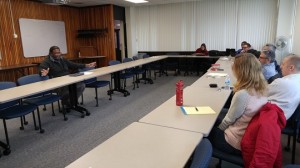History professor shares experiences in Africa during Brown Bag series
Anthony Cheeseboro remembers the night he first dreamed in Arabic.

Dr. Anthony Cheeseboro, history professor, speaks at the Brown Bag series lecture in Peck Hall. (Photo by Joseph Lacdan)
He lay in his bed at the University of Khartoum in South Sudan during his’s dissertation studies at Michigan State University. Then a 30-year old PhD student, he received a research grant to spend time browsing archives on the Gezira Scheme, one of the largest irrigation projects in the world along farming regions along the blue and white Nile.
Cheeseboro, a historical studies professor, shared his experiences researching the Gezira Scheme during the History Department’s Brown Bag Series lecture titled “Africa and Me,” Feb. 12 at Peck Hall.
Cheeseboro arrived in Khartoum on a steamy east African night in the spring of 1990. As he took his first steps off the plane, he was greeted by the sight of 100 armed Sudanese troops. Cheeseboro said he encountered friendly people in Sudan, but the Second Sudanese Civil War and onset of the Persian Gulf War became difficult to ignore, and he had arrived about two months before Saddam Hussein invaded Kuwait.
With the ongoing military conflict, Cheeseboro knew his best protection from military harassment was to remain silent. The country was in a police state where it remains today. The government instituted a 10 p.m. curfew and Cheeseboro said some military police questioned him, accusing him of changing money on the black market. Cheeseboro said the Sudanese people were very welcoming, but the ongoing military conflicts made his research more difficult. Cheeseboro spent a few months studying at the University of Khartoum in the nation’s capital city, then traveled south to study the Gezira archives in Barakat small community located in the irrigated cotton fields.
Cheeseboro also discussed the British occupation and control of Sudan. The British originally set aside 2 million acres for cotton cultivation for the Gezira Scheme which the British started in 1925.
“In America, so often being black is your defining characteristic” Cheeseboro said. “When you go overseas, being American becomes your defining characteristic.”
“Sudan’s the only place in my life I was ever called light-skinned,” Cheeseboro said. Cheeseboro also discussed the diversity and different ethnicities in the Sudan, including minorities such as the Nubian people that live near the northern borders and the Beja people in the east. Different sects of people had their own cultures and notions of race.
Cheeseboro said some Sudanese identify as Arabs, others as native black and others as mixed races. Many Sudanese trace their ancestry to tribes that migrated south from the Arabian Peninsula during the 12th and 13th centuries. Cheeseboro said that many Sudanese who consider themselves as Arabs would be considered black in America.
“I knew that race was defined a little bit differently than it was defined over here,” Cheeseboro said. “And to be in that environment, it definitely showed me how in different parts of the world people define race differently. One of the things that we talk about in academia is that race is a social construct. … The dividing line between races tends to be a social one, not a biological one. Sudan is a good example of that.”
Originally the young PhD student had planned to research in Sudan for about a year but left because of the pending Gulf War and the Sudanese allegiance to Iraq. Cheeseboro studied the administration of the Gezira school. He later published articles in the academic journal Northeast African Studies during the mid 1990s. He said he finished much of his research for those articles in the United States.
Filed Under: African Studies • Black Studies • Historical Studies












